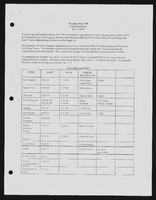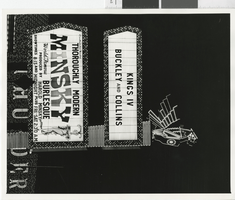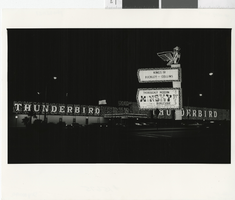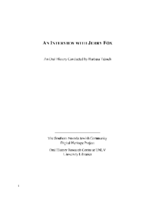Search the Special Collections and Archives Portal
Search Results

Photograph of Boyd and Prell, image 003
Date
Description
Image
1983 Presentation Tape: Moulin Rouge, Suzanne Somers, Circus performers: video
Date
Archival Collection
Description
"Presentation tape" consisting of compilation of clips from Moulin Rouge performance (?), Suzanne Somers performing at MGM Grand, and various circus performers. Audio present for about half the video. Original media U-matic S, color, aspect ratio 4 x 3, frame size 720 x 486. From the Production Company Audiovisual Collection (MS-00930) -- Digitized audiovisual material file.
Moving Image
Archie C. Grant Photograph Collection
Identifier
Abstract
The Archie C. Grant Photograph Collection (1914-1968) contains black-and-white photographs of Nevada politician Archie C. Grant. The materials include photographs of Grant with the Las Vegas Housing Authority at groundbreaking ceremonies, the University of Nevada Board of Regents, and with other Nevada politicians. Materials also contain early photographs of the University of Nevada, Las Vegas campus, including the dedication of Maude Frazier Hall.
Archival Collection
Archie and Zora Grant Papers
Identifier
Abstract
The Archie and Zora Grant Papers document the lives of Archie and Zora Grant from 1918 to 1973. Materials include scrapbooks, clippings, correspondence, records, certificates, and awards pertaining to Archie’s career in the Nevada Legislature, the State Board of Education, Las Vegas Housing Authority, and Las Vegas Chamber of Commerce.
Archival Collection

Alpha Kappa Alpha Sorority, Theta Theta Omega Chapter Founders Day committee reports
Date
Archival Collection
Description
From the Alpha Kappa Alpha Sorority, Incorporated, Theta Theta Omega Chapter Records (MS-01014) -- Chapter records file.
Text

Photographs of Harley Davidson Cafe signs, Las Vegas (Nev.), 2002
Date
Archival Collection
Description
Site address: 3725 S Las Vegas Blvd
Sign owner: Marc Packer
Sign details: Just north of the Tourist center the Harley Davidson cafe sits on the corner of Harmon and Las Vegas Blvd, facing west, with the corner pointing to the northwest. This properties exterior signage consists of two wall marquee wall signs on the west and north faces of the building, a small hanging sign above the entrance, a tall north/south facing pylon sign on the south end of the concrete courtyard that comprises the front of the property. A giant three-dimensional sculpture of a Harley Davidson motorcycle is integrated into the structure of the building to appear as if it is bursting out of the northwest corner of the building. Above the motorcycle is a marquee cabinet advertising for the cafe.
Sign condition: Structure 5 Surface 5 Lighting 5 Notes: See description
Sign form: Pylon; Fascia
Sign-specific description: On the west and north faces of the building, "Harley Davidson Cafe" is spelled in a continuous channel design, only being interrupted by the break between the rest of the text and the word "Cafe." This text is supported by a sleek, black, steel cabinet, that mimics the style of font used for the logo. The letters are crafted of red, shallow, steel channel letters, with white neon around the border as well as red neon on the interior. Standing on the South end of the property the pylon sign is reminiscent of old roadside pole signs, for it is mostly pole. The faceted pole is finished in polished stainless steel giving it highly metallic finish. At the top of the sign a sculpted marquee cabinet holds the advertisement for the cafe. The top portion of the cabinet is the Harley Davidson text logo, supported by an inverted triangle shape, with two lengths running along the underside of the text. The design for the letters is the same as that found on the buildings wall signs with white neon outlining the text, with red neon on the interior. The cabinet itself, without the text, is bordered with red neon, illuminating the highly polished surface of the cabinet. Underneath the Harley Davidson text on the outstretched arms the text "Las Vegas" is spelled in small, black, channel letters with white neon on the interior. Inside the inverted triangle shape created by the cabinet, is another inverted red triangle created by an open channel pan. Cutting across the triangle is channel letters, which spell the word "cafe" painted white on the interior. This text is filled with white neon. The pole continues above the cabinet a short distance. Along the length of the pole, "V" shaped channels repeat, forming a sort of directional sign pointing toward the ground. The channels are filled with tubes of red neon. These chase each other downward pointing toward the plaza and a small blurb of text painted at eye level in red paint. The phrase reads "The best BBQ in Las Vegas," in all caps. The text is then overlaid with red neon. The cabinet on the top of the pylon is repeated over the giant replica motorcycle, facing northwest, upon the northwest face of the wall. The neon scheme is the same as the pylon sign but the "cafe text" is filled with incandescent bulbs. Beneath the motorcycle, and directly over the door, a small back-lit version of the northwest wall above head height.
Sign - type of display: Neon; Incandescent; Backlit
Sign - media: Steel
Sign - non-neon treatments: Graphics
Sign animation: Chasing, flashing, oscillating
Notes: The incandescent bulbs inside the text reading "Paris" on the balloon oscillate rapidly.
Sign environment: Harmon and Las Vegas Boulevard plays host to the Aladdin, which includes the Blue Note jazz and blues club. The Harley Davidson Cafe's sun drenched patio creates the west facade while it stretches east down Harmon to face the Blue Note. This orientation actually creates an intimate feel to the street, seemingly separated from the strip.
Sign manufacturer: Mikhon Lighting and Sign
Sign designer: Roger Pratt
Sign - date of installation: 1999
Sign - thematic influences: The theme of the exterior revolves around the design of the Harley Davidson motorcycle. The slightly italicized Impact text is reminiscent of the text seen on the motorcycles' fuselages. The vertical pylon sign is clearly influenced by roadside, marquee pylon signs, treated in a material also reminiscent of the steel beasts. The exposed metal exterior of the poles can only be associated with the aesthetic so commonly associated with the vehicles.
Sign - artistic significance: Similar to properties that are representative of everyday establishments such as McDonald's and Walgreen's, the Harley Davidson is representative of the themed restaurant, catered to a family environment. It too is an everyday occurrence, of a cafe, dressed with a theme to attract patrons, as well as survive and fit it in the context Las Vegas Blvd Even though the themed restaurant is a popular idea abroad, The Harley Davidson fits in with its partners in the themed cafe industry such as the NASCAR Cafe and Planet Hollywood. Many restaurants among the casinos are themed but, there are only a few that are independently represented with their own signage. The giant replica of the Harley Davidson is also in the tradition of other giant Casino mascots throughout local history. Such mascots could include The Coin King, Mr. O' Lucky, and the original Aladdin sculpture.
Surveyor: Joshua Cannaday
Survey - date completed: 2002
Sign keywords: Chasing; Flashing; Oscillating; Pylon; Fascia; Neon; Incandescent; Backlit; Steel; Graphics
Mixed Content

Photograph of the Thunderbird marquee, Las Vegas (Nev.), 1970-1979
Date
Archival Collection
Description
Image

Photograph of the Thunderbird marquee and parking lot, Las Vegas (Nev.), 1970-1979
Date
Archival Collection
Description
Image

Transcript of interview with Willie Jones, James Jones, and Jamet Jones by Robbin Mc Laurin, March 5, 1980
Date
Archival Collection
Description
On March 5, 1980, collector Robbin McLaurin interviews three members of the Jones family, Willie, James, and Jamet Jones (born 1923, 1920, and 1961, respectively) in the Jones home. Mr. and Mrs. Jones were born in Forest, Mississippi, and relocated to Las Vegas, Nevada, for employment related purposes. This interview covers Las Vegas, past and present.
Text

Transcript of interview with Jerry Fox by Barbara Tabach, November 12, 2014
Date
Archival Collection
Description
Interview with Jerry Fox by Barbara Tabach on November 12, 2014. In this interview, Fox discusses his father's restaurant, Foxy's Delicatessen, which opened on the Las Vegas Strip in the 1950s, and his own business endeavors including the Tinder Box and an embroidery business.
Jerry Fox grew up in Los Angeles until his family moved to Las Vegas in February 1955, where his father opened Foxy's Delicatessen, the city's first Jewish deli. Jerry would go on to follow in his father's entrepreneurial footsteps, operating several ventures across different industries, including his own restaurant, Foxy Dog. Jerry sold Foxy Dog in 1975 after going through a divorce, the same year that Foxy's Deli closed.
Text
